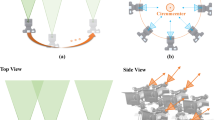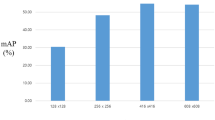Abstract
Global motion estimation and compensation (GME/GMC) is an important video processing technique and has been applied to many applications including video segmentation, sprite/mosaic generation, and video coding. In MPEG-4 Advanced Simple Profile (ASP), GME/GMC is adopted to compensate camera motions. Since GME is important, many GME algorithms have been proposed. These algorithms have two common characteristics, huge computation complexity and ultra large memory bandwidth. Hence for realtime applications, a hardware accelerator of GME is required. However, there are many hardware design challenges of GME like irregular memory access and huge memory bandwidth, and only few hardware architectures have been proposed. In this paper, we first analyzed three typical algorithms of GME, and a fast GME algorithm is proposed. By using temporal prediction and skipping the redundant computation, 91% memory bandwidth and 80% iterations are saved, while the performance is kept, compared to Gradient Descent in MPEG-4 Verification Model. Based on our proposed algorithm, a hardware architecture of GME is also presented. A new scheduling, Reference-Based Scheduling, is developed to solve the irregular memory access problem. An interleaved memory arrangement is applied to satisfy the memory access requirement of interpolation. The total gate count of hardware implementation is 131 K with Artisan 0.18 um cell library, and the internal memory size is about 7.9 Kb. Its processing ability is MPEG-4 ASP@L3, which is 352×288 with 30 fps, at 30 MHz.












Similar content being viewed by others
References
Dufaux, F., & Konrad, J. (2000). Efficient, robust, and fast global motion estimation for video coding. IEEE Transactions on Image Processing, 9, 497–501.
Erturk, S. (2003). Digital image stabilization with sub-image phase correlation based global motion estimation. IEEE Transactions on Consumer Electronics, 49, 1320–1325.
Hoetter, M. (1989). Differential estimation of the global motion parameters zoom and pan. Signal Processing, 16, 249–265, March.
Lu, Y., Gao, W., & Wu, F. (2001). Sprite generation for frame-based video coding. In Proc. of IEEE int. conf. on image processing (Vol. 1, pp. 473–476).
Lu, Y., Ga, W., & Wu, F. (2002). Automatic video segmentation using a novel background model. In Proc. of IEEE int. symp. on circuits syst. (Vol. 3, pp. 807–810), May.
ISO/IEC (2001). Text of ISO/IEC 15938-3/FCD information technology – multimedia content description interface - part 3 visual. ISO/IEC JTC 1/SC 29/WG11 N4062.
Manjunath, B. S., Salembier, P., & Sikora, T. (2002). Introduction to MPEG-7. New York: Wiley.
Smolic, A., Sikora, T., & Ohm, J.-R. (1999). Long-term global motion estimation and its application for sprite coding, content description, and segmentation. IEEE Transactions on Circuits and Systems for Video Technology, 9(8), 1227–1242.
Irani, M., Anandan, P., & Hsu, S. (1995). Mosaic based representations of video sequences and their applications. In Proc. of IEEE int. conf. on comput. vision (pp. 605–611).
Chien, S.-Y., Chen, C.-Y., Chao, W.-M., Hsu, C.-W., Huang, Y. W., & Chen, L.-G. (2002). A fast and high subjective quality sprite generation algorithm with frame skipping and multiple sprites techniques. In Proc. of IEEE int. conf. on image processing (Vol. 1, pp. 193–196).
Lu, Y., Gao, W., & Wu, F. (2003). Efficient background video coding with static sprite generation and arbitrary-shape spatial prediction techniques. IEEE Transactions on Circuits and Systems for Video Technology, 13(8), 394–405, May.
Chen, C.-Y., Chien, S.-Y., Chen, Y.-H., Huang, Y.-W., & Chen, L.-G. (2003). Unsupervised object-based sprite coding system for tennis sport. In Proc. of IEEE int. conf. multimedia expo (Vol. 1, pp. 337–340).
ISO/IEC (1999). Information technology – coding of audio-visual objects – part 2: visual. ISO/IEC 14496-2.
Dufaux, F. (1996). Results for video coding using dynamic sprite (core experiment N3). ISO/IEC JTC1/SC29/WG11 M1458.
Steinbach, E., Wiegand, T., & Girod, B. (1999). Using multiple global motion models for improved block-based video coding. In Proc. of IEEE int. conf. on image processing (Vol. 2, pp. 56–60).
Keller, Y., & Averbuch, A. (2003). Fast gradient methods based on global motion estimation for video compression. IEEE Transactions on Circuits and Systems for Video Technology, 13(8), 300–309.
Stolberg, H.-J., Berekovic, M., Pirsch, P., & Runge, H. (2002). The MPEG-4 advanced simple profile - a complexity study. In Proc. of 2002 workshop and exhibition on MPEG-4 (pp. 33–36).
Fu, M.-F., Au, O., & Chan, W.-C. (2003). Fast global motion estimation based on local motion segmentation. In Proc. of IEEE int. conf. on image processing (Vol. 3, pp. 367–370).
Moscheni, F., Dufaux, F., & Kunt, M. (1995). A new two-stage global/local motion estimation based on a background/foreground segmentation. In Proc. of IEEE int. conf. on acoust., speech, and signal processing (pp. 2261–2264).
Kim, E. T., & Kim, H.-M. (1998). Fast and robust parameter estimation method for global motion compensation in the video coder. IEEE Transactions on Consumer Electronics, 45(1), 76–83.
MPEG Video Group (2001). The MPEG-4 video standard verification model version 18.0. ISO/IEC JTC 1/SC 29/WG11 N3908.
Wu, S. F., & Kittler, J. (1990). A differential method for simultaneous estimation of rotation, change of scale and translation. Signal Processing: Image Communication, 2(1), 69–80, May.
Adolph, D., & Buschmann, R. (1991). 1.15Mbit/s coding of video signals including global motion compensation. Signal Processing: Image Communication, 3(2–3), 259–274, June.
Chan, W.-C., Au, O., & Fu, M.-F. (2002). A novel predictive global motion estimation for video coding. In Proc. of IEEE int. symp. on circuits syst. (Vol. 3, pp. 5–8), May.
Berekovic, M., Stolberg, H.-J., & Pirsch, P. (2002). Multicore system-on-chip architecture for MPEG-4 streaming video. IEEE Transactions on Circuits and Systems for Video Technology, 12(8), 688–699.
Irani, M., & Peleg, S. (1993). Motion analysis for image enhancement: Resolution, occulusion and transparency. Journal of Visual Communication and Image Representation, 4(4), 324–335.
Badawy, W., & Bayoumi, M. (2002) A multiplication-free algorithm and a parallel architecture for affine transformation. Journal of VLSI Signal Processing, 31(2), 173–184, June.
Marquardt, D. W. (1963). An algorithm for least-squares estimation of nonlinear parameters. Journal of the Society for Industrial and Applied Mathematics, 11, 431–441.
Chen, C.-Y., Chien, S.-Y., Chao, W.-M., Huang, Y.-W., & Chen, L.-G. (2004). Hardware architecture for global motion estimation for MPEG-4 advanced simple profile. In Proc. of IEEE int. symp. on circuit and system (Vol. 2, pp. 23–26), May.
Richter, H., Smolic, A., Stabernack, B., & Muller, E. (2001). Real time global motion estimation for an MPEG-4 video encoder. In Proceedings of picture coding symposium (pp. 25–27).
Chien, S.-Y., Chen, C.-Y., Chao, W.-M., Huang, Y.-W., & Chen, L.-G. (2003). Analysis and hardware architecture for global motion estimation in MPEG-4 advanced simple profile. In Proc. of int. symp. on circuits syst. (Vol. 2, pp. 720–723), May.
Author information
Authors and Affiliations
Corresponding author
Rights and permissions
About this article
Cite this article
Chen, YH., Chien, SY., Chen, CY. et al. Analysis and Hardware Architecture Design of Global Motion Estimation. J Sign Process Syst Sign Image Video Technol 53, 285–300 (2008). https://doi.org/10.1007/s11265-008-0169-7
Received:
Revised:
Accepted:
Published:
Issue Date:
DOI: https://doi.org/10.1007/s11265-008-0169-7




